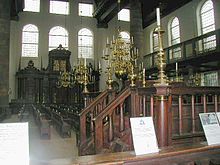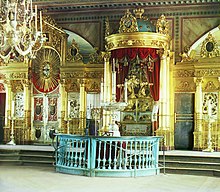Bema
A bema was an elevated platform used as an orator's podium in ancient Athens. The term can refer to the raised area in a sanctuary. In Jewish synagogues, where it is used for Torah reading during services, the term used is bima or bimah.
Ancient Greece[edit]

The Ancient Greek bēma (βῆμα) means both 'platform' and 'step', being derived from bainein (βαίνειν, 'to go').[1][2][3][4][5] The original use of the bema in Athens was as a tribunal from which orators addressed the citizens as well as the courts of law, for instance, in the Pnyx. In Greek law courts the two parties to a dispute presented their arguments each from separate bemas.
By metonymy, bema was also a place of judgement, being the extension of the raised seat of the judge, as described in the New Testament, in Matthew 27:19 and John 19:13, and further, as the seat of the Roman emperor, in Acts 25:10, and of God, in Romans 14:10, when speaking in judgment.
Judaism[edit]
This section needs additional citations for verification. (December 2021) |


Etymology[edit]
The post-Biblical Hebrew bima (בּימה), 'platform' or 'pulpit', is almost certainly derived from the Ancient Greek word for a raised platform, bema (βῆμα). A philological link to the Biblical Hebrew bama (בּמה), 'high place' has been suggested.
Alternative names[edit]
The bimah (Hebrew plural: bimot) in synagogues is also known as the almemar or almemor among some Ashkenazis[6] (from the Arabic, al-minbar, meaning 'platform'[7]). Among Sephardic Jews it is known as a tevah (literally 'box, case' in Hebrew)[1] or migdal-etz[8] ('tower of wood').[9]
Purpose[edit]
The importance of the bimah is to show that the reader is the most important at that moment in time, and to make it easier to hear their reader of the Torah.
Description and use[edit]
The bimah became a standard fixture in synagogues from which the weekly Torah portion (parashah) and the haftarah are read.
In antiquity the bimah was made of stone, but in modern times it is usually a rectangular wooden platform approached by steps.[10]
The synagogue bimah is typically elevated by two or three steps, as was the bimah in the Temple. A raised bimah will typically have a railing. This was a religious requirement for safety in bimah more than 10 handbreadths high, or between 83 and 127 centimetres (2.72 and 4.17 ft). A lower bimah (even one step) will typically have a railing as a practical measure to prevent someone from inadvertently stepping off.
In Orthodox Judaism, the bimah is located in the center of the synagogue, separate from the Ark. In other branches of Judaism, the bimah and the Ark are joined together.[citation needed] Prior to Reform Judaism, all synagogues had their bimah in the middle[dubious ] .[11] The Reform movement moved theirs close to or around the aron kodesh (Holy Ark).[10]
At the celebration of the Shavuot holiday when synagogues are decorated with flowers, many synagogues have special arches that they place over the bimah and adorn with floral displays.
Christianity[edit]

The ceremonial use of a bema carried over from Judaism into early Christian church architecture. It was originally a raised platform with a lectern and seats for the clergy, from which lessons from the Scriptures were read and the sermon was delivered. In Western Christianity the bema developed over time into the chancel (or presbytery) and the pulpit.
In Byzantine, Armenian Rite, West Syriac and Alexandrian Rites of Eastern Christianity bema generally remains the name of the platform which composes the sanctuary; it consists of both the area behind the iconostasion and the platform in front of it from which the deacon leads the ektenias (litanies) together with the ambo from which the priest delivers the sermon and distributes Holy Communion. It may be approached by one or several steps. The bema is composed of the altar (the area behind the iconostasion), the soleas (the pathway in front of the iconostasion), and the ambo (the area in front of the Holy Doors which projects westward into the nave). Orthodox laity do not normally step up onto the bema except to receive Holy Communion.
Islam[edit]
In Islam, a pulpit, called minbar, is a standard furnishing in every Friday mosque. The earliest record of a minbar dates back to between 628 and 631 CE.
See also[edit]
- Ambon (liturgy)
- High place, raised place of worship
- Peak sanctuaries
- Templon
- Tribune (architecture)
References[edit]
- ^ a b Steinmetz, Sol (2005). Dictionary of Jewish Usage. Rowman & Littlefield. ISBN 978-0-7425-4387-4.
- ^ Henry George Liddell, Robert Scott, Roderick McKenzie. A Greek-English Lexicon. Oxford: Clarendon, 1940, s.v. βῆμα Archived 2018-09-04 at the Wayback Machine.
- ^ Hjalmar Frisk. Griechisches etymologisches Wörterbuch. Heidelberg: Carl Winter, 1960, s.v. βαίνω (p. 208).
- ^ Pierre Chantraine. Dictionnaire étymologique de la langue grecque. Paris: Klincksieck, 2009 [1968], s.v. βαίνω (p. 157).
- ^ Robert Beekes and Lucien van Beek. Etymological Dictionary of Greek. Leiden: Brill, 2010, s.v. βαίνω (p. 192).
- ^ almemar [ælˈmiːmɑː], Collins English Dictionary
- ^ However, a far more likely origin of almemar is the Arabic word al-ma'mur meaning 'judge' which is in keeping with our understanding of 'bimah'. "Almemar in Jewish Encyclopedia (1906)". Jewish Encyclopedia (1906). Retrieved 2013-11-13.
- ^ Joseph Gutmann (1983). Iconography of Religions: The Jewish sanctuary. Brill. p. 15. ISBN 90-04-06893-7.
- ^ Wischnitzer, Rachel (1964). The architecture of the European synagogoue. Jewish Publication Society of America. p. 34.
- ^ a b Britannica Concise Encyclopædia: "bema"
- ^ Besser, Yisroel (2018). The Chasam Sofer. Artscroll. p. 10. ISBN 978-1-4226-2232-2.
a bimah must be in the middle
External links[edit]
 Media related to Bimot at Wikimedia Commons
Media related to Bimot at Wikimedia Commons
